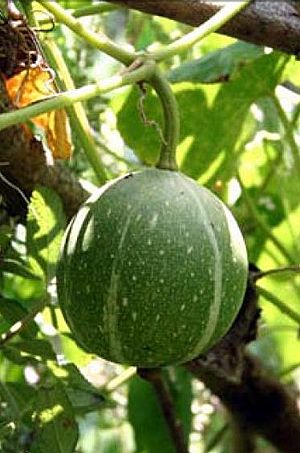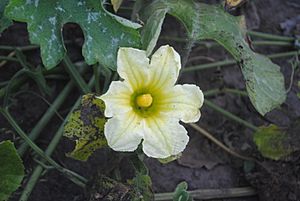Okeechobee gourd facts for kids
Quick facts for kids Okeechobee gourd |
|
|---|---|
 |
|
| C. okeechobeensis subsp. okeechobeensis | |
| Conservation status | |
| Scientific classification | |
| Genus: |
Cucurbita
|
| Species: |
okeechobeensis
|
| Synonyms | |
|
|
Cucurbita okeechobeensis, the Okeechobee gourd, is a species of gourd in the family Cucurbitaceae, native to Mexico and the United States. There are two subspecies; one is endemic to Florida, primarily in the region around Lake Okeechobee, the other to the State of Veracruz in eastern Mexico. Once abundant, it has state and federal listing as an endangered species.
One of its peculiarities is the yellow corolla not so common in other Cucurbita species
Contents
Taxonomy
The taxonomy of the species and subspecies is uncertain. It was formerly classified as Pepo okeechobeensis.
Some authorities divide it into two subspecies:
- Cucurbita okeechobeensis subsp. martinezii — Martinez gourd, - State of Veracruz in Mexico
- Cucurbita okeechobeensis subsp. okeechobeensis — Okeechobee gourd - State of Florida in United States
Description
A climbing vine, C. okeechobeensis leaves have irregular serrate margins with 5 to 7 angular, shallow lobes. Overall the leaf blades are heart or kidney-shaped. Young leaves are covered with downy hair. The bell-shaped flowers are cream-colored, with long corollas (6 to 7 cm).
Ecology
It was often found growing on abandoned alligator nests in pond apple (Annona glabra) groves near Lake Okeechobee.
Images for kids






